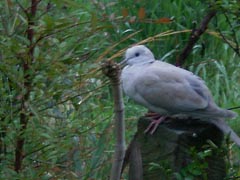
Mourning Dove (Zenaida macroura), Glen Burnie, Maryland, April 2011. Photo by Diane F. Evartt.
Since the earliest days of colonial settlement, Maryland has been described as a land of natural beauty. Situated on the border between temperate and tropical climes, with access to both salt and fresh waters, the State offers a unique diversity in topography and biology.
Countless different species* may be observed in Maryland's natural areas, and are divided by numerous physical features. The most abundant families are amphibia (amphibians); arthropods (crustaceans, insects, & spiders); aves (birds); mammalia (mammals); and reptilia (reptiles). Often, they are classified further by diet, as carnivores, herbivores, and omnivores, although this division can be narrowed to define specific dietary habits, such as insectivores.
Maryland maintains nearly forty thousand acres of wildlands, which are encompassed by State parks, forests, and wildlife management areas. These areas allow for Maryland's natural wildlife to thrive virtually undisturbed. State wildlands are protected by law, and are monitored and protected by the Department of Natural Resources Police Force.
*(specific animals are classified by eight main taxonomic ranks: domain; kingdom; phylum; class; order; family; genus; and species)
Maryland Geological Survey
Maryland Government
Maryland Constitutional Offices & Agencies
Maryland Departments
Maryland Independent Agencies
Maryland Executive Commissions, Committees, Task Forces, & Advisory Boards
Maryland Universities & Colleges
Maryland Counties
Maryland Municipalities
Maryland at a Glance
Maryland Manual On-Line
Search the Manual
e-mail: mdmanual@mdarchives.state.md.us
© Copyright Maryland State Archives

![[photo, Eastern Snapping Turtle (Chelydra s. serpentina), Annapolis, Maryland]](/msa/mdmanual/01glance/wildlife/reptiles/images/1198-1-5957a.jpg)